Endometrial Stromal Sarcoma
Endometrial stromal sarcoma (ESS) is a rare malignant tumor of the endometrium, occurring in the age group of 40-50 years.
History
The 50-year-old, female patient presented with menorrhagia ,lower abdominal pain and heaviness.
On examination she was found to have large abdominal pelvic mass.
An ultrasound was done; it shows large mass inseparable from uterus with some vascularity.
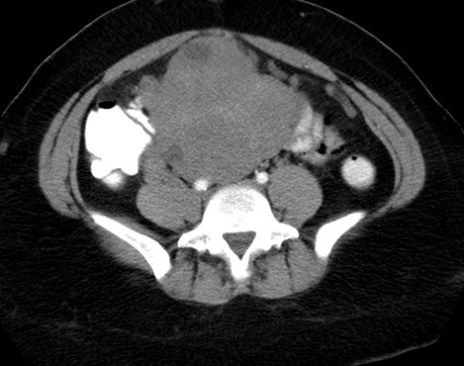

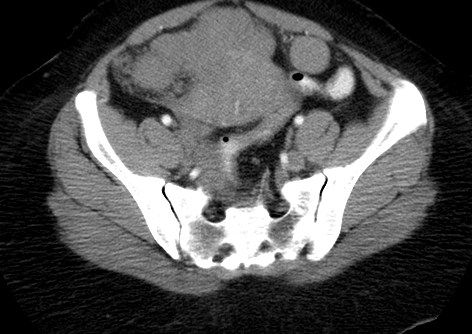
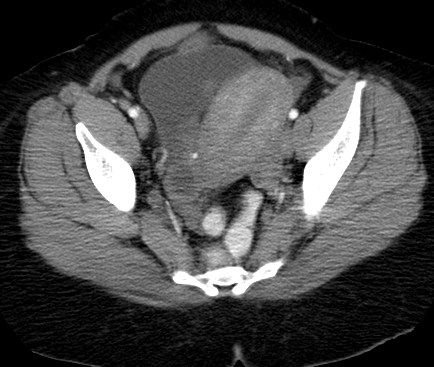
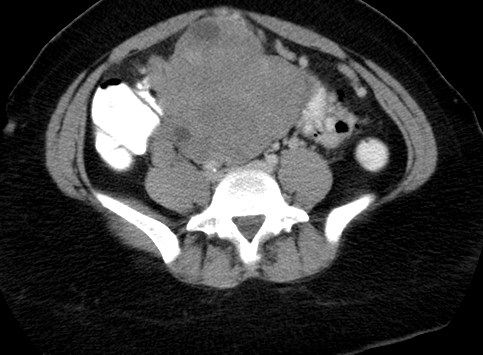
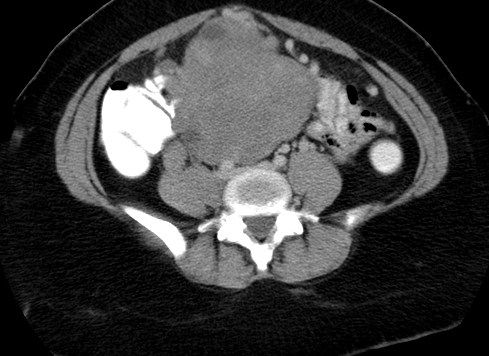



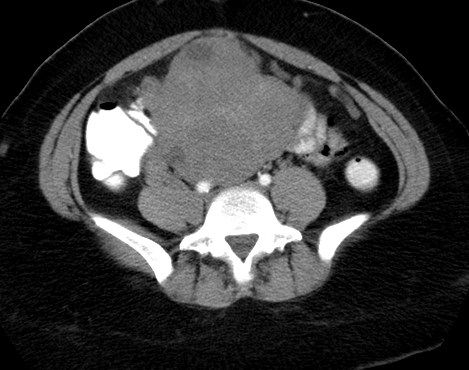
A CT provided further evaluation.
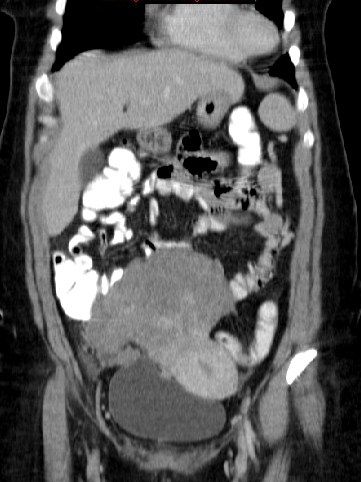
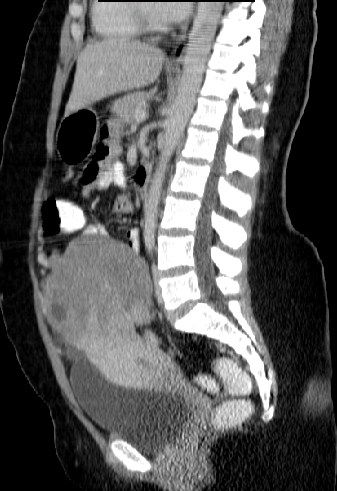
There is a large, lobulated mass inseparable from fundus of uterus; it shows heterogenous enhancement with lots of vascularity around mass, more at anterior margin. There are a few small, low-density areas within the mass representing cystic degeneration. A few small nodules are around the large mass and are completely separate from the mass.
The mass is causing compression over pelvis colon. The endometrium is clearly visible. The lesion appears to be solid.
The rest of the exam is within normal limits.
Differential Diagnosis
The differential diagnosis of a relatively hypervascular, soft-tissue mass arising from the apex of the uterus includes, large subserosal fibrod, or a primary malignancy of the uterus (such as leiomyosarcoma).
Diagnosis
Endometrial stromal sarcoma
Discussion
Pathology Discussion:
A total hysterectomy with was performed along with resection of surrounding nodules, omentum and colonic mucosa. The pathological findings were leading to the diagnosis of endometrial stromal sarcoma. This tumor does not involve the ovaries or fallopian tubes. Lymphovascular invasion was there. Extensive involvement of colonic wall with unremarkable colonic mucosa.Extemsive omental involvement and nodule was positive for deposit.
Radiology Discussion:
Uterine sarcomas represent 2-5% of all uterine malignancies. There are three types: carcinosarcoma (also known as mixed mullerian tumor) is the most common, leiomyosarcoma is next, and endometrial stromal sarcoma (ESS) is the least common (<10% of uterine sarcomas). Endometrial stromal sarcomas are composed of cells that are identical to or closely resemble normal proliferative-phase endometrial stromal cells. These tumors may arise from the endometrium but can also be seen in the setting of adenomyosis or endometriosis.
Endometrial stromal sarcoma typically occurs in women between the ages of 42 and 59 years. Symptoms include abnormal uterine bleeding and pain. Risk factors are fairly nonspecific and include prior pelvic radiation therapy, age, and race (slightly higher incidence among blacks). There may also be hormonal factors, though this is not well understood. The differential diagnosis for ESS includes leiomyoma with cystic degeneration, leiomyosarcoma, and endometrial carcinoma. The subtle differences between these entities are best demonstrated with MRI.
On MR, endometrial stromal sarcomas appear as large tumors in the endometrial cavity and/or myometrium. The signal is typically high on T1-weighted images and heterogeneously high on T2-weighted images. The tumor margins are typically irregular, often with marginal nodular lesions. Intramyometrial worm-like nodular extensions may be visible. Hemorrhage and necrosis are common. Most ESS show greater enhancement than normal myometrium. Overall, ESS are difficult to differentiate from leiomyomas with cystic degeneration, leiomyosarcomas, and endometrial carcinomas.
There are, however, several imaging features that differentiate ESS from those other tumors. Endometrial carcinomas typically do not display irregular marginal lesions, marginal nodules or intramyometrial nodules. The avid enhancement pattern of ESS (relative to the myometrium) is also not typical for endometrial carcinomas. Leiomyomas and leiomyosarcomas generally do not have the high T2 signal that is characteristic of ESS. In addition, these tumors display a different pattern of enhancement; markedly increased signal after contrast is unusual. Finally, leiomyomas typically do not have irregular margins with small nodules (though these features may be seen in leiomyosarcomas).
References
Ueda M, et al. MR imaging findings of uterine endometrial stromal sarcoma: Differentiation from endometrial carcinoma. Eur Radiol. (2001) 11: 28-33.
Ueda M, et al. Uterine endometrial stromal sarcoma located in uterine myometrium: MRI appearance. Eur Radiol. (2000)10, 780-782.
Gandolfo, et al. Endometrial stromal sarcoma of the uterus: MR and US findings, Eur Radiol. (2000) 10, 776-779.
Clarius Mobile Health Unveils Anterior Knee Feature for Handheld Ultrasound
April 23rd 2025The T-Mode Anterior Knee feature reportedly offers a combination of automated segmentation and real-time conversion of grayscale ultrasound images into color-coded visuals that bolster understanding for novice ultrasound users.
The Reading Room Podcast: Current Perspectives on the Updated Appropriate Use Criteria for Brain PET
March 18th 2025In a new podcast, Satoshi Minoshima, M.D., Ph.D., and James Williams, Ph.D., share their insights on the recently updated appropriate use criteria for amyloid PET and tau PET in patients with mild cognitive impairment.
What is the Best Use of AI in CT Lung Cancer Screening?
April 18th 2025In comparison to radiologist assessment, the use of AI to pre-screen patients with low-dose CT lung cancer screening provided a 12 percent reduction in mean interpretation time with a slight increase in specificity and a slight decrease in the recall rate, according to new research.